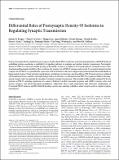Differential Roles of Postsynaptic Density-93 Isoforms in Regulating Synaptic Transmission
Author(s)
Kruger, Juliane M.; Favaro, Plinio D.; Liu, Mingna; Kitlinska, Agata; Huang, Xiaojie; Raabe, Monika; Akad, Derya S.; Liu, Yanling; Urlaub, Henning; Dong, Yan; Xu, Weifeng; Schluter, Oliver M.; ... Show more Show less
DownloadKrueger-2013-Differential Roles o.pdf (2.550Mb)
PUBLISHER_POLICY
Publisher Policy
Article is made available in accordance with the publisher's policy and may be subject to US copyright law. Please refer to the publisher's site for terms of use.
Terms of use
Metadata
Show full item recordAbstract
In the postsynaptic density of glutamatergic synapses, the discs large (DLG)-membrane-associated guanylate kinase (MAGUK) family of scaffolding proteins coordinates a multiplicity of signaling pathways to maintain and regulate synaptic transmission. Postsynaptic density-93 (PSD-93) is the most variable paralog in this family; it exists in six different N-terminal isoforms. Probably because of the structural and functional variability of these isoforms, the synaptic role of PSD-93 remains controversial. To accurately characterize the synaptic role of PSD-93, we quantified the expression of all six isoforms in the mouse hippocampus and examined them individually in hippocampal synapses. Using molecular manipulations, including overexpression, gene knockdown, PSD-93 knock-out mice combined with biochemical assays, and slice electrophysiology both in rat and mice, we demonstrate that PSD-93 is required at different developmental synaptic states to maintain the strength of excitatory synaptic transmission. This strength is differentially regulated by the six isoforms of PSD-93, including regulations of α-amino-3-hydroxy-5-methyl-4-isoxazole propionic acid (AMPA) receptor-active and inactive synapses, and activity-dependent modulations. Collectively, these results demonstrate that alternative combinations of N-terminal PSD-93 isoforms and DLG-MAGUK paralogs can fine-tune signaling scaffolds to adjust synaptic needs to regulate synaptic transmission.
Date issued
2013-09Department
Massachusetts Institute of Technology. Department of Brain and Cognitive Sciences; Picower Institute for Learning and MemoryJournal
Journal of Neuroscience
Publisher
Society for Neuroscience
Citation
Kruger, J. M., P. D. Favaro, M. Liu, A. Kitlinska, X. Huang, M. Raabe, D. S. Akad, et al. “Differential Roles of Postsynaptic Density-93 Isoforms in Regulating Synaptic Transmission.” Journal of Neuroscience 33, no. 39 (September 25, 2013): 15504–15517.
Version: Final published version
ISSN
0270-6474
1529-2401